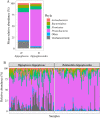Insights into the circulating microbiome of Atlantic and Greenland halibut populations: the role of species-specific and environmental factors
- PMID: 37045892
- PMCID: PMC10097863
- DOI: 10.1038/s41598-023-32690-6
Insights into the circulating microbiome of Atlantic and Greenland halibut populations: the role of species-specific and environmental factors
Abstract
Establishing long-term microbiome-based monitoring programs is critical for managing and conserving wild fish populations in response to climate change. In most cases, these studies have been conducted on gut and, to a lesser extent, skin (mucus) microbiomes. Here, we exploited the concept of liquid biopsy to study the circulating bacterial microbiome of two Northern halibut species of economic and ecological importance. Amplification and sequencing of the 16S rRNA gene were achieved using a single drop of blood fixed on FTA cards to identify the core blood microbiome of Atlantic and Greenland halibut populations inhabiting the Gulf of St. Lawrence, Canada. We provide evidence that the circulating microbiome DNA (cmDNA) is driven by genetic and environmental factors. More specifically, we found that the circulating microbiome signatures are species-specific and vary according to sex, size, temperature, condition factor, and geographical localization. Overall, our study provides a novel approach for detecting dysbiosis signatures and the risk of disease in wild fish populations for fisheries management, most notably in the context of climate change.
© 2023. The Author(s).
Conflict of interest statement
The authors declare no competing interests.
Figures







Similar articles
-
Divergent bacterial landscapes: unraveling geographically driven microbiomes in Atlantic cod.Sci Rep. 2024 Mar 13;14(1):6088. doi: 10.1038/s41598-024-56616-y. Sci Rep. 2024. PMID: 38480867 Free PMC article.
-
Movements of a deep-water fish: establishing marine fisheries management boundaries in coastal Arctic waters.Ecol Appl. 2017 Apr;27(3):687-704. doi: 10.1002/eap.1485. Epub 2017 Mar 13. Ecol Appl. 2017. PMID: 27984681
-
Interpopulation Variation in the Atlantic Salmon Microbiome Reflects Environmental and Genetic Diversity.Appl Environ Microbiol. 2018 Aug 1;84(16):e00691-18. doi: 10.1128/AEM.00691-18. Print 2018 Aug 15. Appl Environ Microbiol. 2018. PMID: 29915104 Free PMC article.
-
The northern shrimp (Pandalus borealis) offshore fishery in the Northeast Atlantic.Adv Mar Biol. 2007;52:147-266. doi: 10.1016/S0065-2881(06)52002-4. Adv Mar Biol. 2007. PMID: 17298891 Review.
-
Potential for Monitoring Gut Microbiota for Diagnosing Infections and Graft-versus-Host Disease in Cancer and Stem Cell Transplant Patients.Clin Chem. 2017 Nov;63(11):1685-1694. doi: 10.1373/clinchem.2016.259499. Epub 2017 Jul 18. Clin Chem. 2017. PMID: 28720679 Free PMC article. Review.
Cited by
-
Expanding the use of circulating microbiome in fish: contrast between the gut and blood microbiome of Sebastes fasciatus.ISME Commun. 2025 Jul 11;5(1):ycaf116. doi: 10.1093/ismeco/ycaf116. eCollection 2025 Jan. ISME Commun. 2025. PMID: 40800616 Free PMC article.
-
A brain microbiome in salmonids at homeostasis.Sci Adv. 2024 Sep 20;10(38):eado0277. doi: 10.1126/sciadv.ado0277. Epub 2024 Sep 18. Sci Adv. 2024. PMID: 39292785 Free PMC article.
-
Divergent bacterial landscapes: unraveling geographically driven microbiomes in Atlantic cod.Sci Rep. 2024 Mar 13;14(1):6088. doi: 10.1038/s41598-024-56616-y. Sci Rep. 2024. PMID: 38480867 Free PMC article.
References
-
- Kess T, Einfeldt AL, Wringe B, Lehnert SJ, Layton KK, McBride MC, Robert D, Fisher J, Le Bris A, den Heyer C, Shackell N. A putative structural variant and environmental variation associated with genomic divergence across the Northwest Atlantic in Atlantic Halibut. ICES J. Mar. Sci. 2021;78(7):2371–2384. doi: 10.1093/icesjms/fsab061. - DOI
-
- DFO. Assessment of the Gulf of St. Lawrence (4RST) Greenland halibut stock in 2020. DFO Can. Sci. Advis. Sec. Sci. Advis. Rep. 2021/017. (2021).
-
- DFO. Stock Assessment of Gulf of St. Lawrence (4RST) Atlantic Halibut in 2020. DFO Can. Sci. Advis. Sec. Sci. Advis. Rep. 2021/034. (2021).
-
- Shackell NL, Fisher JA, den Heyer CE, Hennen DR, Seitz AC, Le Bris A, Robert D, Kersula ME, Cadrin SX, McBride RS, McGuire CH. Spatial ecology of Atlantic Halibut across the Northwest Atlantic: A recovering species in an era of climate change. Rev. Fisheries Sci. Aquac. 2022;30(3):281–305. doi: 10.1080/23308249.2021.1948502. - DOI
Publication types
MeSH terms
Substances
LinkOut - more resources
Full Text Sources

